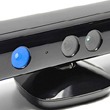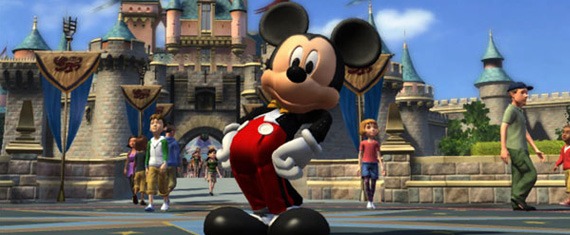 Having vacationed at the Disney Parks 24 times — quite a feat for a native Oregonian — I’m one of the most biased yet oddly qualified people to review Kinect Disneyland Adventures. On the one hand, I’m clearly a Disneyland and Disney World fan, so I’m predisposed to liking the new Xbox 360 game. On the other hand, because I’ve been to the parks so often and have a virtually photographic memory of their layouts, I’m going to be the game’s harshest critic if it misses anything. With all that said, let me quell your fears with a one-clause review: Kinect Disneyland Adventures is one of the best and most creative games for Xbox Kinect.
Having vacationed at the Disney Parks 24 times — quite a feat for a native Oregonian — I’m one of the most biased yet oddly qualified people to review Kinect Disneyland Adventures. On the one hand, I’m clearly a Disneyland and Disney World fan, so I’m predisposed to liking the new Xbox 360 game. On the other hand, because I’ve been to the parks so often and have a virtually photographic memory of their layouts, I’m going to be the game’s harshest critic if it misses anything. With all that said, let me quell your fears with a one-clause review: Kinect Disneyland Adventures is one of the best and most creative games for Xbox Kinect.
Before Dance Central and Kinect Sports fans tear me a new one, stop to consider the new game’s originality. Dancing games have been around since the first DDR exploded in the arcades, and the home consoles’ motion-controlled titles represent little more than an evolved but technically impressive version of the dance pad. Motion-controlled sports games, meanwhile, have largely been derivative since Wii Sports, which isn’t necessarily a bad thing but also doesn’t scream “original recipe.”
Kinect Disneyland Adventures lets gamers explore a digital world, not just dance on a static stage. It lets players swing, slice, run, jump, dodge and lean their way through a diverse mix of ride-based mini-games, not just repeat the same motion in six different sports. And somehow, it does this all while re-creating the experience of being in one of the most recognized, popular tourist destinations in the world. If that’s not an accomplishment, I don’t know what is.
To be perfectly clear, Kinect Disneyland Adventures is geared toward kids. Adult fans will enjoy it but won’t be as enthralled as the younger crowd. For starters, the game offers zero challenge, because none of the ride-based mini-games allows players to fail. If you bump into an obstacle, get whacked by a projectile, are sliced by a pirate or experience any other form of would-be failure, the on-screen avatar simply blinks for a while and goes on his or her merry way. There is no losing in this game.
The biggest challenge in the game doesn’t come from a boss battle or mini-game; it comes from the somewhat-awkward way players have to point their fingers and move their arms to navigate through the Park. Mastering the dozens of mini-games requires serious skill, don’t get me wrong, so older perfectionists may find intrigue in timing their jumps perfectly and gathering every single coin. But that mastery is completely optional. No special levels unlock or stay closed based on performance; you simply get different-colored yet inconsequential pins.
The sheer amount of “stuff” to do in the fully rendered Disneyland park also lends itself well to younger gamers. From waving a magic wand and collecting coins to shooting things with Buzz Lightyear’s blaster and taking pictures of Hidden Mickeys, the game fulfills kids’ apparent need to jump from one activity to the next at the press of a button. Or, in this case, with the raising of a hand. The game even has some kid-friendly “RPG lite” elements, because while interacting with Disney characters, the player will receive a series of tasks to complete in any given order. Having multiple adventures/quests could be overwhelming, but you never have to complete them in any particular order, and a yellow trail similar to that in the Fable games helps direct players to their primary objective. If you want to track the adventures that are still incomplete, you can open up the Adventure Journal by going to the “pause” screen (hold both hands above your head for three seconds), which will also allow you to see how many pins you’ve earned, view a park map, and look at the photo albums or autograph books you’ve purchased in the Park using coins.

Oh, and about that in-game Park: it’s perfect. The environmental audio throughout Disneyland is spot-on, from ambient ride sounds to the area-specific soundtracks. Believe me, I have 4GB of Park audio; I know the music like the back of my hand. The architecture is rendered to a “T” as well, all the way down to trash can placements and the attraction posters underneath Main Street Station. Even the light in the second-story window of the Main Street Fire Station is illuminated as it should be. The “in park” experience is so authentic, in fact, that my son was able to navigate from Frontierland all the way to the Astro Orbitor. He knew how to do it in real life, so he knew how to do it in Kinect Disneyland Adventures.
As you make your way through the digitized Park, you obviously encounter the rides that make Disneyland so special. Naturally you can’t really ride them — a fact that absolutely confounded my five year-old for the longest time — but almost all the rides have a series of appropriately-themed mini-games within them. The Matterhorn, for instance, includes three chapters, each of which involves slightly different gameplay mechanics. The first game involves leaning side to side to navigate a bobsled down a snowy hill, whereas the second requires throwing snowballs at a tribe of whack-a-mole-like abominable snowmen (note: it makes your arm really tired, and it requires you to actually aim at their position on the TV screen). The third chapter is another leaning mini-game, this time with your avatar on skis. One thing I noticed on this ride in particular was that the leaning was overly sensitive for accuracy-prone adults, yet it worked just fine for my tentatively-leaning son.
On the Big Thunder Mountain mini-games, however, the leaning was much more accurate, although it’s not a primary gameplay mechanic. The first chapter involves leaning from side to side to reach coins and hit switches, but the primary activity is pumping your arms up and down to move a mine cart through the Monument Valley-like environ. The second chapter, meanwhile, has players jumping and ducking to avoid obstacles while reaching around to grab coins. The speed of this second chapter made it very hard to get a good sense of depth, so timing the movements precisely as obstacles and birds come flying at you was difficult, and the twists and turns made it extremely challenging to navigate. Yet as I said before, the game never lets players fail, so it offers something for perfectionists while staying fun for younger gamers.
Other rides offer an equally diverse mix of gameplay options. In Peter Pan’s Flight, for instance, you do everything from fly around London and Never Never Land to dodge cannonballs and engage in a swordfight with Captain Hook. In Pirates of the Caribbean, you’re compelled to do everything from mimicking a dancing pirate and dueling with Blackbeard to sneaking through the Town Square scene and using a sword to send grenades ricocheting back toward sheltered pirates. Wherever you go, there’s always a slight variation on the gameplay from the previous ride, which keeps things fresh and ensures the game never feels old.
That’s the goal Imagineers have had for years when expanding upon the Disneyland experience — making it always seem fresh and new — so it’s impressive to see Kinect Disneyland Adventures achieve that same level of excellence. I was continually impressed with its originality and attention to detail, and the drop-in/drop-out co-op is a perfect feature for households with multiple kids. As I said in the beginning of this review, I was predisposed to liking this game if it was done well, but I was equally ready to be its biggest critic. There’s very little criticism here; if you’re looking for a sure-fire winner for the young Disney fans in your house this holiday, buy Kinect Disneyland Adventures.
Click this link to buy the game from Amazon.com: Kinect Disneyland Adventures.
Score: 9 — Navigation can be a challenge for youngsters, but the diversity of mini-games, authenticity and overall production values are impressive.
